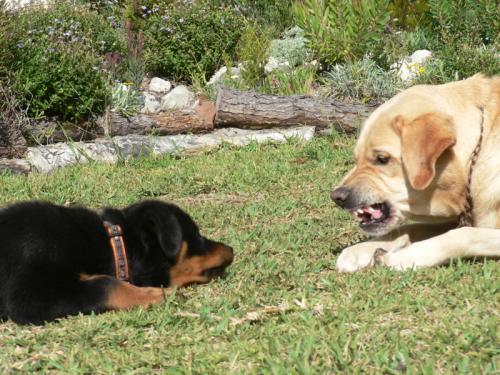Most people, even those who don’t spend with dogs a lot time, understand that wagging his tail means “friend”, and growling – “enemy”. Yes, perhaps it is, but other than that in dogs there are tons of other signals. Understanding Your Dog’s Body Language and the signals that it gives is an essential part building healthy relationships with your pet. Let’s go further consider these signals in more detail and in more detail, as well as how and why use them when communicating with the dog.

Tail wagging
Contents
If your dog wags its tail, then it’s most likely the moment is comfortable and safe. She may be glad to see you ready to play or just enjoying the moment. If the dog wags tail at the sound of your voice, then this indicates her strong connection with you and a sense of well-being in your presence. Not less, dogs wag their tails differently to denote different emotions. For example, if the tail is slightly raised and wagging carried out by its middle part, then this usually indicates to friendship. If the tail is raised high and has an unusual position, and the dog wags them slowly – this may be a sign of interest and suspicions, so you need to approach such a dog with caution.
Dog wags its tail and barks
A dog that wags its tail and barks at the same time can seem ambivalent, as these are conflicting signals – tail wagging usually means friendly, fun behavior, in while barking is often associated with aggression. Dog’s insight This situation means that you must take into account other signals that it shows, such as tail position, if it is raised too high, then it most likely cannot be associate with friendly behavior. Reared wool at the withers, growl and slow “warning” tail wagging, accompanied by barking and defensive posture, may be a signal aggression.
Dog shows teeth
An open mouth is not necessarily a signal of aggression – a lot dogs run and play with their mouths open and of course often stick out tongue to cool, so this is normal behavior for a dog. If the dog purses his lips or grins, especially if it accompanied by a growl coming deep from the chest, with a dense pose, this is an important warning to which stands to listen.
Growl
A growl is almost always defensive or aggressive reaction to which special attention should be paid and Regards You should never get close to a growling dog, which you do not know, and moreover, you should not try to stroke it or enter her personal space. However, some dogs can growl during the game, on any toy or even on own owner, without taking any action. You must understand their dog in order to distinguish a warning growl from the game, although you should always stop the irrational growling dogs, even during the game, to teach her the right behavior, as the situation can easily get worse if you don’t take her under control at an early stage.
Pretailed tail
Tightened tail and low, submissive position of the dog’s body, like as if she is sneaking, indicating humility or timid behavior, as something alarmed or frightened her. remember, that a shy dog can quickly become aggressive, therefore try not to support this behavior, but instead, speak calmly and kindly, try to encourage the dog to approach you.
Flat ears
Ears pressed and turned back are considered a signal when the dog close to aggressive behavior, because it feels threatened. Pinched ears may be accompanied by a growl or defensive behavior. It is necessary to approach such a dog with a special caution.
Ears are pointed
Pointed ears in a dog usually indicate alertness and interest in anything. Reading helps to understand the dog in this situation. other signals of her body, for example, where she is looking, than interested in? Perhaps she was interested in the ball, a potential prey or bowl of food?
Whining
Choking can have many causes, including excitement, boredom, pain, or unhappiness. Again, in this situation it is necessary consider your dog’s surroundings to understand the root cause whining.
The dog lies upside down
Turning over on his back and showing his stomach, the dog may seem cute and make you think she wants her rubbed his stomach, and this may be quite so. However, exposure the abdomen and neck is a reaction of humility on the part of the dog and indicates that she cedes superiority to another person or the dog. You could probably see this behavior in the game of dogs, when they get to know each other and in this way show their hierarchy in the pack.
Jumping in place
Jumping is usually a signal of excitement and means that your dog may like to play and is ready for it when jumping is accompanied by other signals, such as a wagging tail. However, jumping in place should not be encouraged. Such behavior can be extremely annoying for most people to have a dog jumped in place and stained clothes, or even caused injury, therefore, you should prevent such jumps with hard the word “no” and positive reinforcement, if observed.
Pose
Along with wagging tail, eye contact and voice, pose your dog’s is one of its most important indicators mood and possible behavior. Lying hunched belly pose to the ground without eye contact most likely indicates fear or submission. Standing posture usually indicates interest. Wool on end at the withers, tight posture, vigilance, especially if it accompanied by a growl and strong eye contact – indicates threatening aggression.
Eye contact
A dog should never be embarrassed by a stare or make prolonged eye contact with her, as this is usually perceives as aggression, which can lead to either unreasonable dog submission reactions, or aggression responses. Looking a dog directly in the eyes is considered a “rough” treatment in dogs and if the dog decisively looks into your eyes, this may indicate on her potentially aggressive behavior.
Don’t forget about safety
Familiarize yourself with your dog’s main signals and hints, to catch her mood and feelings and react accordingly way. Never approach a dog that you don’t know, and never touch someone else’s dog without the permission of its owner. Such behavior can be quite rude towards dogs, and even potentially dangerous.
You cannot think that any dog prone to aggression in a public place will have a muzzle, so you should not consider dogs without muzzles to be obviously friendly. Besides, a dog can be muzzled for many reasons, sometimes in as a precaution so that she cannot damage her potential prey, which can chase, and therefore far from all dogs in the muzzles are aggressive. Again, the first thing to do is act according to what the dog owner says and then you need independently “read” the dog’s signals before approaching her.






